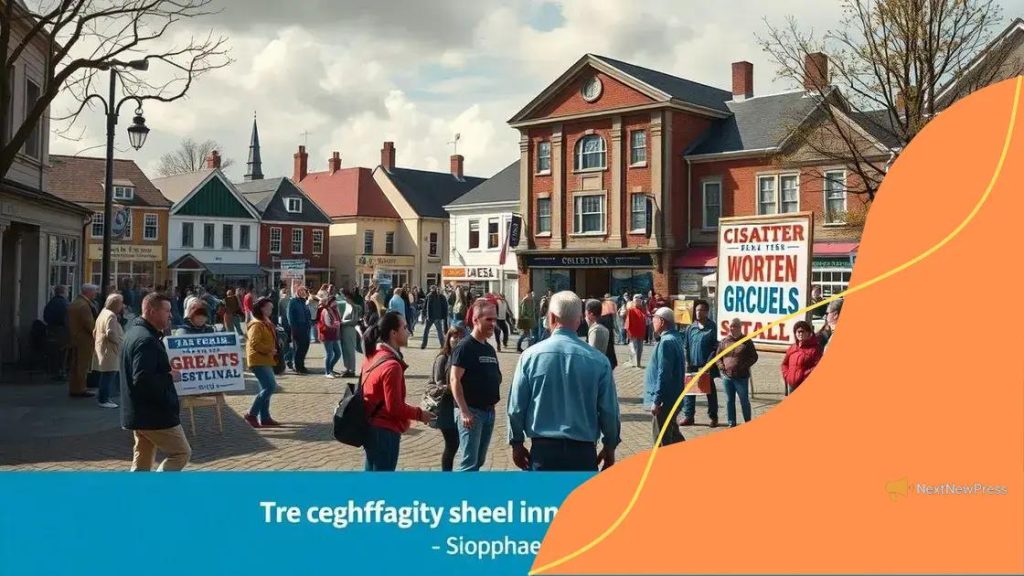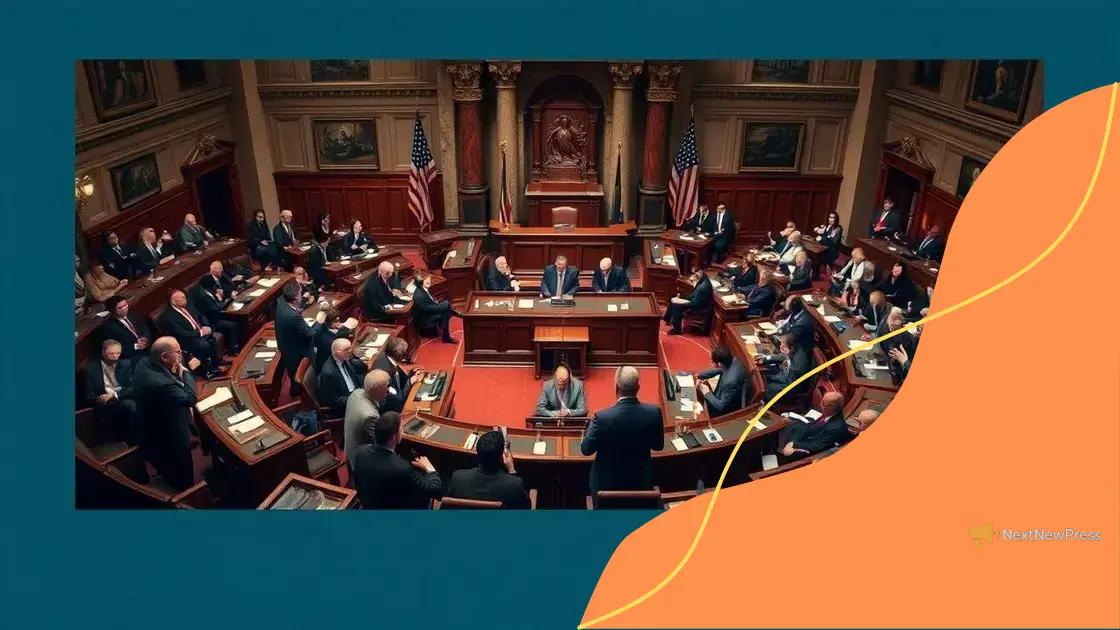Long-term effects of political polarization on society

The long-term effects of political polarization include a significant decline in social cohesion, increased distrust within communities, and detrimental impacts on democracy, necessitating strategies to bridge divides through open dialogue and community engagement.
Long-term effects of political polarization are shaping our political landscape in ways we often overlook. Have you noticed how news divides us more than unites? In this article, we explore its implications.
Understanding political polarization
Understanding political polarization is crucial in today’s society. It refers to the growing divide between different political ideologies, often leaving little room for compromise or middle ground. This phenomenon can be observed in various aspects of social life, including media consumption, political discourse, and even personal relationships.
What Causes Political Polarization?
Several factors contribute to the rise of political polarization. Here are some primary reasons:
- Media Influence: Media outlets often cater to specific ideologies, shaping how individuals perceive issues.
- Social Identity: People tend to align closely with groups that share their beliefs, creating echo chambers.
- Political Messaging: Both parties use strong messaging to mobilize support, which can deepen divides.
These elements create a feedback loop that intensifies existing divisions. As people engage more with like-minded individuals, their perspectives become more entrenched. But, this isn’t just about personal beliefs; it significantly impacts how politics functions.
Consequences of Polarization
As political polarization escalates, its effects can be seen in various areas:
- Legislative Gridlock: Compromise becomes rare in a polarized environment, leading to stalled legislation.
- Community Fragmentation: Communities become divided, making collaboration and local governance harder.
- Increased Misinformation: Polarized audiences are more susceptible to misinformation that aligns with their views.
The implications of these consequences are profound. When political discussions turn hostile, it hampers effective governance and leads to societal rifts. One of the significant challenges facing democracies today is bridging these divides.
To combat this, efforts aimed at fostering dialogue and understanding are vital. Encourage discussions that promote empathy and respect for differing opinions. By doing this, we can start to address the issues stemming from polarization.
Historical context of polarization
The historical context of polarization provides essential insights into how current political divides have developed. Over the decades, various events and movements have contributed to the deepening of these divides. Understanding this background helps us grasp the present landscape of political discourse.
Key Historical Events
Several significant events in history have exacerbated political polarization:
- The Civil Rights Movement: This era highlighted deep societal divides based on race, influencing political alignments.
- Vietnam War Protests: Opposition to the Vietnam War created factions within political parties, leading to differing ideologies.
- Rise of Partisan Media: With the establishment of cable news, media outlets began to cater to specific political bases, reinforcing existing biases.
The ramifications of these events continue to affect contemporary politics. As society evolved, so did the platforms and agendas of political parties. The shift in voter demographics has also played a significant role in this polarization.
Changes in Political Parties
Throughout history, the two major political parties in the United States have undergone changes that reflect shifts in public sentiment. As issues like climate change, healthcare, and immigration grew in prominence, parties adapted their stances to respond to constituents. This adaptation sometimes resulted in fracturing within parties, as moderates and extremists pulled in different directions.
Furthermore, the Internet revolution has transformed how individuals engage with politics. With social media, viewpoints can spread rapidly and often without fact-checking. This immediate sharing can create an environment where misinformation thrives, leading to further divides. As a result, people become more entrenched in their views, which perpetuates polarization.
Consequences on democratic processes

The consequences on democratic processes due to political polarization are significant and multifaceted. As political divides widen, the traditional functioning of democracy faces challenges that can undermine its core principles. Increased polarization leads to a more fragmented political landscape.
Impact on Elections
In polarized environments, election campaigns often focus less on issues and more on attacking opponents. This dynamic can deter voters from engaging with candidates, as they may feel disillusioned by negative campaigning. Voter turnout can be influenced by feelings of frustration, as many believe their voice may not matter.
- Partisan Voter Behavior: Voters tend to support candidates solely based on party affiliation rather than individual merits.
- Influence of Extremist Views: More extreme factions within parties can shift the overall party platform, steering it away from moderate positions.
- Voter Suppression: Polarized politics may lead to laws that make it harder for specific groups to vote.
The influence of money in politics also amplifies polarization. Wealthy donors often support candidates who align with partisan extremes, further entrenching divisions. This results in policies that do not reflect the broader population’s interests, making democracy feel elitist.
Legislative Gridlock
Another significant consequence of polarization is legislative gridlock. When parties refuse to compromise, important issues remain unaddressed. Gridlock can slow down progress on critical topics like healthcare, education, and climate change, frustrating citizens who expect governmental action.
In this context, public trust in government can decline. Citizens may lose faith in elected officials and institutions, resulting in increased apathy towards political participation. When individuals believe their representatives do not prioritize their needs, engagement decreases.
Understanding these consequences is vital. Addressing the challenges posed by polarization will require innovative approaches to dialogue and compromise, crucial for a healthy democracy.
Impact on social cohesion
The impact on social cohesion due to political polarization is profound and far-reaching. As divisions intensify, communities often experience a breakdown in trust and communication. This fragmentation can lead to a decline in overall social harmony, affecting relationships at both personal and community levels.
Effects on Community Interactions
When political polarization rises, interactions among community members can become strained. People may start to avoid discussions about politics, fearing conflict with those who hold opposing views. As a result, this avoidance can lead to a lack of understanding. Here are some key effects:
- Increased Distrust: People may distrust those who think differently, creating barriers to friendship.
- Social Isolation: Individuals might withdraw from groups or activities that do not align with their beliefs.
- Reduction in Volunteerism: Community initiatives often require cooperation across differences, which becomes harder with polarization.
This atmosphere of division fosters a climate where empathy diminishes. Without mutual understanding, cooperation between diverse groups becomes challenging, hurting community welfare. Social gatherings can devolve into arguments rather than celebrations of shared interests.
Long-term Consequences
The long-term consequences of polarization on social cohesion can be alarming. For instance, polarized societies tend to see increased violence in conflict situations. As tensions rise, individuals may express their anger in harmful ways, leading to vandalism, protests, or even riots.
Furthermore, when social services and support are needed, communities can struggle to unite around common goals. Programs aimed at improving community health, education, and safety can falter due to lack of collaboration. As trust erodes, the fabric of society weakens, making recovery from crises much harder.
Strategies for bridging divides
Strategies for bridging divides in a polarized world are essential for fostering understanding and cohesion. In today’s climate, it is crucial to create pathways for dialogue, encouraging empathy and reducing hostilities. Effective strategies can help individuals and communities come together despite their differences.
Encouraging Open Dialogue
One of the primary methods for bridging divides is promoting open and respectful dialogue. This allows individuals to share their perspectives without judgment. Here are key approaches:
- Listening Actively: Encourage people to listen fully to opposing views before responding. This builds understanding and respect.
- Creating Safe Spaces: Establish environments where individuals feel comfortable expressing their beliefs without fear of backlash.
- Facilitating Discussions: Organize moderated discussions that promote healthy debate on important topics.
These tactics enhance communication and reduce the emotional temperature of confrontational situations. As dialogue deepens, individuals can find common ground, even among differing opinions.
Promoting Community Engagement
Engaging communities in collective activities can also contribute to bridging divides. When individuals work together towards shared goals, they begin to see each other as partners rather than adversaries. Initiatives like community service, local events, or cooperative programs can be effective.
By participating in joint projects, community members cultivate relationships based on teamwork. These experiences can break down stereotypes and build friendships. As trust grows, polarized views become less significant in personal interactions.
In addition, educational workshops can increase awareness about various perspectives and experiences. By understanding each other’s backgrounds, communities can develop empathy and compassion. This foundation is critical for addressing societal challenges collaboratively.
FAQ – Questions About Bridging Political Divides
What is the importance of open dialogue in reducing polarization?
Open dialogue allows individuals to express their views without fear, fostering understanding and respect across differing opinions.
How can communities engage in activities to bridge divides?
Communities can organize events, service projects, or discussions that promote teamwork and build relationships among diverse groups.
Why is empathy crucial in addressing political polarization?
Empathy enables individuals to understand and appreciate differing perspectives, which can ultimately help reduce hostility and division.
What role does education play in bridging divides?
Educational programs can enhance awareness of various viewpoints, encouraging open-mindedness and constructive dialogue among community members.





